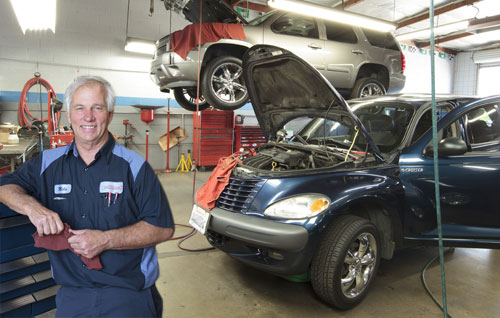Myths About Auto Care
Myth: Engine oil should be changed every 3,000 miles.
Despite what oil companies and quick-lube shops often claim, it's usually not necessary. Its okay to consider the recommended service intervals in your car's owner's manual. Under normal driving conditions, some vehicle manufacturers suggest intervals as high as 7,500 miles or even more between oil changes. (Keep in mind the recommendations in the owner’s manual are the minimum service intervals).
Changing oil more often doesn't hurt the engine,
but it can cost extra money over the life of the vehicle. On the other hand, some automakers often recommend 3,000-mile intervals for severe driving conditions, such as constant stop-and-go driving, frequent trailer-towing, mountainous terrain, or dusty conditions. I prefer servicing and changing the oil somewhere between the 7,500 and 3,000 miles. If you don’t drive 12,000—15,000 miles a year I like to see your vehicle at leasttwice a year for service and inspection
in order to remain confident you don’t encounter problems on the road. Please bear in mind the inspection and review of your car’s repair and maintenance is as important, if not more so, as the oil change itself.
The tire PSI (pounds-per-square-inch) figure on the side of the tire is the maximum pressure that the tire can safely hold, not the automaker's recommended pressure, which provides the best balance of braking, handling, gas mileage, and ride comfort. That vehicle manufacture figure is usually found on a driver door-jamb sticker. We check and adjust tire pressure with every oil change service.
Myth: If the brake fluid is low, topping it off will fix the problem.
As brake pads wear, the level in the brake-fluid reservoir drops a bit. That can help you monitor brake wear.
If the fluid level drops
to or below the Low mark on the reservoir, then either your brakes are worn out or fluid is leaking. Either way you need to get the brake system serviced immediately. You should also get a routine brake inspection when you rotate the tires, about every 6,000 to 7,000 miles.Myth: If regular-grade fuel is good, premium must be better.
Most vehicles are engineered to run just fine on regular-grade (87 octane) fuel. Using premium in these cars won't hurt, but it won't improve performance, either. A higher-octane number simply means that the fuel is less prone to pre-ignition problems, so it's often specified for hotter running, high-compression engines. So if your car is designed for 87-octane fuel, don't waste money on premium. I also worry about the quality of the high octane gasoline because I assume it sits in the underground tank in the gas station for a longer period of time due to the popular use of 87 octane.
Myth: Flush the coolant with every oil change.
Radiator coolant doesn't need to be replaced very often. Most owners’ manuals recommend changing the coolant every five years or 60,000 miles, some even longer. Of course, if the level in the coolant reservoir is chronically low, check for a leak and get service as soon as possible.
Myth: After a jump-start, your car will soon recharge the battery.
If your battery was dead due to leaving the lights or something else on it could take hours of driving to restore a battery's full charge. That's because power accessories, such as heated seats, air conditioning, draw so much electricity that in some cars the alternator has little left over to recharge a run-down battery. A "load test" at a service station can determine whether the battery can still hold a charge. If so, several hours on a battery charger might be needed to revive the battery to its full potential.
Myth: Let your engine warm up for several minutes before driving.
That might have been good advice for yesteryear's cars but is less so today. Modern engines warm up more quickly and run so much better while warming up than they use too. And the sooner they warm up, the sooner they reach maximum efficiency and deliver the best fuel economy and performance. In the extreme cold don’t rev the engine high or accelerate hard in the first few blocks after starting off.
Myth: A dealership must perform regular maintenance to keep your car's factory warranty valid.
As long as the maintenance items specified in the vehicle owner's manual are performed on schedule, the work can be done at any auto-repair shop. If you're knowledgeable, you can even do the work yourself. Just keep accurate records and receipts to back you up in case of a warranty dispute on a future repair.
Myth: Dishwashing and laundry detergents make a good car wash.
Detergent can strip off a car's wax finish. Instead, use a car-wash liquid, which is formulated to clean without removing wax.
Please feel free to give me a call 909.981.6844.
Servicing foreign and domestic cars in Claremont, Upland, Ontario and beyond in Southern California.
phone: 909.981.6844
cell: 626.643.1323
email: KerberAuto@gmail.com
©2025 Kerber Automotive
website created by Brenda Simon Creations
cell: 626.643.1323
email: KerberAuto@gmail.com
©2025 Kerber Automotive
website created by Brenda Simon Creations




